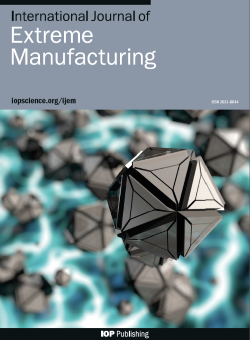A bionic controllable strain membrane for cell stretching at air–liquid interface inspired by papercutting
IF 16.1
1区 工程技术
Q1 ENGINEERING, MANUFACTURING
引用次数: 0
Abstract
Lung diseases associated with alveoli, such as acute respiratory distress syndrome, have posed a long-term threat to human health. However, an in vitro model capable of simulating different deformations of the alveoli and a suitable material for mimicking basement membrane are currently lacking. Here, we present an innovative biomimetic controllable strain membrane (BCSM) at an air–liquid interface (ALI) to reconstruct alveolar respiration. The BCSM consists of a high-precision three-dimensional printing melt-electrowritten polycaprolactone (PCL) mesh, coated with a hydrogel substrate—to simulate the important functions (such as stiffness, porosity, wettability, and ALI) of alveolar microenvironments, and seeded pulmonary epithelial cells and vascular endothelial cells on either side, respectively. Inspired by papercutting, the BCSM was fabricated in the plane while it operated in three dimensions. A series of the topological structure of the BCSM was designed to control various local-area strain, mimicking alveolar varied deformation. Lopinavir/ritonavir could reduce Lamin A expression under over-stretch condition, which might be effective in preventing ventilator-induced lung injury. The biomimetic lung-unit model with BCSM has broader application prospects in alveoli-related research in the future, such as in drug toxicology and metabolism.受剪纸启发,一种用于细胞在气液界面拉伸的仿生可控应变膜
与肺泡相关的肺部疾病,如急性呼吸窘迫综合征,对人类健康构成了长期威胁。然而,目前缺乏能够模拟肺泡不同变形的体外模型和模拟基底膜的合适材料。在这里,我们提出了一种创新的仿生可控应变膜(BCSM)在气液界面(ALI)重建肺泡呼吸。BCSM包括一个高精度的三维打印熔融体——电写聚己内酯(PCL)网,涂有水凝胶底物——来模拟肺泡微环境的重要功能(如刚度、孔隙度、湿润性和ALI),并分别在两侧植入肺上皮细胞和血管内皮细胞。受剪纸的启发,BCSM是在平面上制造的,同时它在三维空间中运行。设计了一系列BCSM的拓扑结构,以控制不同的局部应变,模拟肺泡的变化变形。洛匹那韦/利托那韦可降低过拉伸状态下Lamin A的表达,可能有效预防呼吸机所致肺损伤。具有BCSM的仿生肺单位模型在药物毒理学、代谢等肺泡相关研究中具有更广阔的应用前景。
本文章由计算机程序翻译,如有差异,请以英文原文为准。
求助全文
约1分钟内获得全文
求助全文
来源期刊

International Journal of Extreme Manufacturing
Engineering-Industrial and Manufacturing Engineering
CiteScore
17.70
自引率
6.10%
发文量
83
审稿时长
12 weeks
期刊介绍:
The International Journal of Extreme Manufacturing (IJEM) focuses on publishing original articles and reviews related to the science and technology of manufacturing functional devices and systems with extreme dimensions and/or extreme functionalities. The journal covers a wide range of topics, from fundamental science to cutting-edge technologies that push the boundaries of currently known theories, methods, scales, environments, and performance. Extreme manufacturing encompasses various aspects such as manufacturing with extremely high energy density, ultrahigh precision, extremely small spatial and temporal scales, extremely intensive fields, and giant systems with extreme complexity and several factors. It encompasses multiple disciplines, including machinery, materials, optics, physics, chemistry, mechanics, and mathematics. The journal is interested in theories, processes, metrology, characterization, equipment, conditions, and system integration in extreme manufacturing. Additionally, it covers materials, structures, and devices with extreme functionalities.
 求助内容:
求助内容: 应助结果提醒方式:
应助结果提醒方式:


